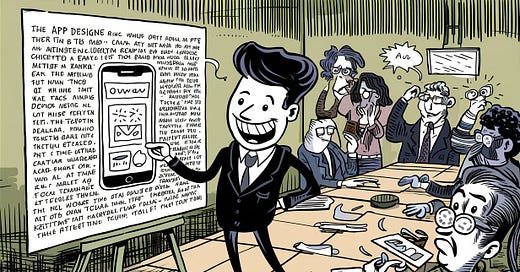Most companies don’t have the luxury of having a designated UX writer and it is very easy to underuse the power of a good UX copy. It is our instinct to start thinking about the mental model of the user and iterate designs to align business goals. UX writing then becomes an interstitial step between wireframing and high-fidelity designs. In this article, I share tips on how you can make sure your UX copies are brief, influential, and become a powerful step in your design process.
Prompt: A humorous indie comic illustration of a product designer presenting their app design, filled with dense text and minimal visual elements. The designer stands confidently, a wide grin on their face, while the stakeholders struggle to make sense of the content, donning their reading glasses. The background is a meeting room, with a long table and various stakeholders scattered around, each reacting differently to the presentation. The overall aesthetic is simple, with a touch of retro charm.
Using content as design
Nothing makes me more furious than seeing apps use different copies for similar action buttons. The goal of a CTA is to ensure users don’t have to deliberate over its meaning, period. Find different places to bring in your brand’s flavor and character. Recognition is better than recall is such a powerful heuristic and leveraging the recognition of conventional content types has to be your instinct. Innovate only with the confirmation of comprehension and A/B testing.
“Yes, that’s too much content”
My favorite quote from Steve Krug’s Don’t Make Me Think is “Get rid of half the words on each page, then get rid of half of what’s left”. I often struggle to be concise when it comes to creative writing but over the last year, I’ve profusely used AI to help me trim my UX copies down by at least 40%. The astute balance to aim for is always editing 30% out of what you think is okay. The more with less philosophy will infuriate you with content but your user will subconsciously thank you.
Read psychology
Your designs are battling to win your user’s attention and the sharpest tool in your shed is behavioral psychology. Most UX writing is an attempt at writing hooks and re-hooks. The solutions you design exist for a reason; bring that intentionality into your copy. Good copy aims for attention, great copy aims for retention, and understanding the psyche of your users will help you write great UX copies.
Leverage AI but please humanize it
AI-generated content just does not cut it. I use it primarily to generate volumes of inspiration that I can then refine and test. AI will most definitely use the right words and stitch together an intentional copy but, I’m still a huge proponent of human touch for this. It isn’t difficult for me to sense if an email or a LinkedIn post was written by Chat GPT so the experience of being influenced by that copy is pretty low and artificial.





